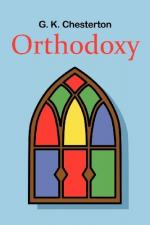Even when I thought, with most other well-informed, though unscholarly, people, that Buddhism and Christianity were alike, there was one thing about them that always perplexed me; I mean the startling difference in their type of religious art. I do not mean in its technical style of representation, but in the things that it was manifestly meant to represent. No two ideals could be more opposite than a Christian saint in a Gothic cathedral and a Buddhist saint in a Chinese temple. The opposition exists at every point; but perhaps the shortest statement of it is that the Buddhist saint always has his eyes shut, while the Christian saint always has them very wide open. The Buddhist saint has a sleek and harmonious body, but his eyes are heavy and sealed with sleep. The mediaeval saint’s body is wasted to its crazy bones, but his eyes are frightfully alive. There cannot be any real community of spirit between forces that produced symbols so different as that. Granted that both images are extravagances, are perversions of the pure creed, it must be a real divergence which could produce such opposite extravagances. The Buddhist is looking with a peculiar intentness inwards. The Christian is staring with a frantic intentness outwards. If we follow that clue steadily we shall find some interesting things.
A short time ago Mrs. Besant, in an interesting essay, announced that there was only one religion in the world, that all faiths were only versions or perversions of it, and that she was quite prepared to say what it was. According to Mrs. Besant this universal Church is simply the universal self. It is the doctrine that we are really all one person; that there are no real walls of individuality between man and man. If I may put it so, she does not tell us to love our neighbours; she tells us to be our neighbours. That is Mrs. Besant’s thoughtful and suggestive description of the religion in which all men must find themselves in agreement. And I never heard of any suggestion in my life with which I more violently disagree. I want to love my neighbour not because he is I, but precisely because he is not I. I want to adore the world, not as one likes a looking-glass, because it is one’s self, but as one loves a woman, because she is entirely different. If souls are separate love is possible. If souls are united love is obviously impossible. A man may be said loosely to love himself, but he can hardly fall in love with himself, or, if he does, it must be a monotonous courtship. If the world is full of real selves, they can be really unselfish selves. But upon Mrs. Besant’s principle the whole cosmos is only one enormously selfish person.




